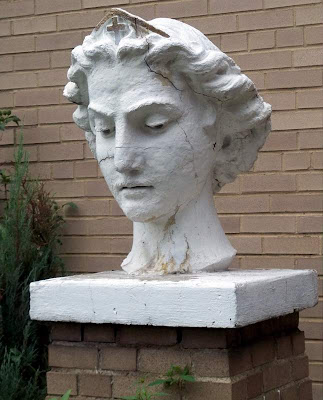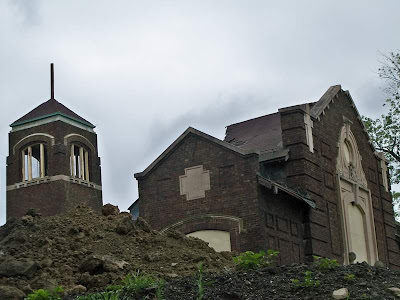 Outside the main entrance to St. Michael's on Scranton in Cleveland, there are two remaining archangels, Gabriel (who has lost his horn), and Raphael (who has retained the fish). Between the landmark pair of uneven steeples, on the gable point of the roof there is an empty pedestal. For years there had been a third archangel, Michael, 22 feet tall. Over time the statue deteriorated, and a fear that it would crash below had it removed. The head was saved and placed in the rectory garden. Saint Michael's is a beautiful and active church and parish. In the sunlight, with the electric lights out, the inside church is peaceful and very comforting. There is color and volume. The space on the perimeter surfaces in all three dimensions is full of image, and the large volume between wall, floor and ceiling gives a balance; and within this space there is calm suited to be near the presence of Jesus.
Outside the main entrance to St. Michael's on Scranton in Cleveland, there are two remaining archangels, Gabriel (who has lost his horn), and Raphael (who has retained the fish). Between the landmark pair of uneven steeples, on the gable point of the roof there is an empty pedestal. For years there had been a third archangel, Michael, 22 feet tall. Over time the statue deteriorated, and a fear that it would crash below had it removed. The head was saved and placed in the rectory garden. Saint Michael's is a beautiful and active church and parish. In the sunlight, with the electric lights out, the inside church is peaceful and very comforting. There is color and volume. The space on the perimeter surfaces in all three dimensions is full of image, and the large volume between wall, floor and ceiling gives a balance; and within this space there is calm suited to be near the presence of Jesus. Huge earthquakes hit Peru. A slave, whose name is lost to history, transported from Angola had painted a mural of Christ during His crucifixion on a wall in the poorest neighborhood in 1651. That image is called Señor de los Milagros de Nazarenas. Jesus, under that title is the patron of the city. Outside that wall converts, often slaves prayed. In 1655 earthquake, the building fell, but not the portion of the painted wall. This devotion of the poorest Peruvians became troublesome to the bishop and the government. It was ordered to be painted over and destroyed, attempts failed. Eventually a church was built around it. On the 20th of October 1687 a catastrophic earthquake hit, causing a tsunami in Japan. Most of Lima was destroyed, but not that painted wall. The 28th of October 1746 Lima, Peru was shook by another earthquake. Thousand died as thousands died during the other quakes, the painting survived. People came to that wall and began a procession, and the trembling stopped. The next year, when an oil painting copy of was mounted on a litter of Señor de los Milagros, a second painting accompanied it. It was that of the Ecuadorian Virgen de la Nube, Our Lady of the Cloud.
Huge earthquakes hit Peru. A slave, whose name is lost to history, transported from Angola had painted a mural of Christ during His crucifixion on a wall in the poorest neighborhood in 1651. That image is called Señor de los Milagros de Nazarenas. Jesus, under that title is the patron of the city. Outside that wall converts, often slaves prayed. In 1655 earthquake, the building fell, but not the portion of the painted wall. This devotion of the poorest Peruvians became troublesome to the bishop and the government. It was ordered to be painted over and destroyed, attempts failed. Eventually a church was built around it. On the 20th of October 1687 a catastrophic earthquake hit, causing a tsunami in Japan. Most of Lima was destroyed, but not that painted wall. The 28th of October 1746 Lima, Peru was shook by another earthquake. Thousand died as thousands died during the other quakes, the painting survived. People came to that wall and began a procession, and the trembling stopped. The next year, when an oil painting copy of was mounted on a litter of Señor de los Milagros, a second painting accompanied it. It was that of the Ecuadorian Virgen de la Nube, Our Lady of the Cloud.Every October it is borne on a silver litter by purple cloaked cargodores and taken through streets of Lima to visit churches. The processions start on the 18th. Crowds of a million are estimated in the city. Peruvians have brought this custom, with them, when they have emigrated. The first procession in the US, was in NYC 1972.
Cleveland's church of Saint Michael the Archangel joins in the observance, a little early in the month—this Sunday. It will be the tenth Cleveland procession.












































